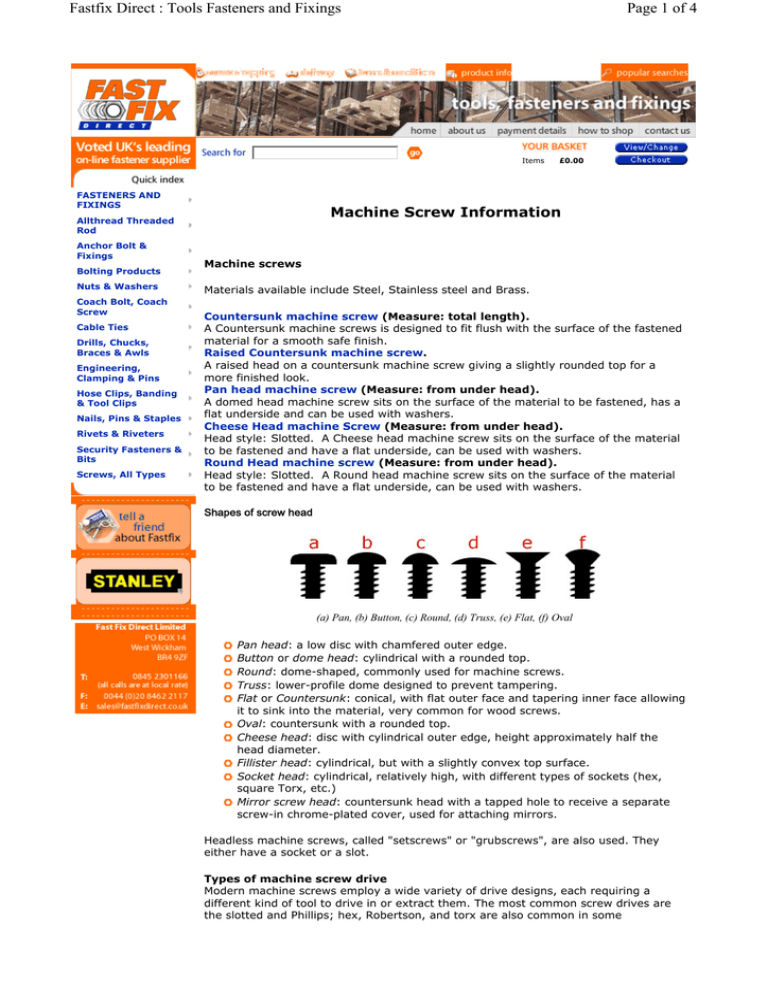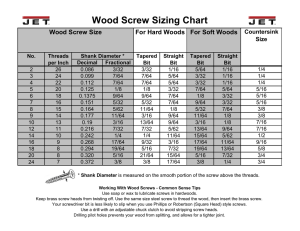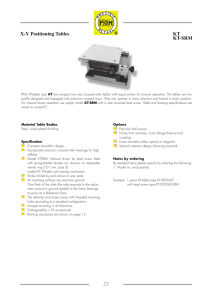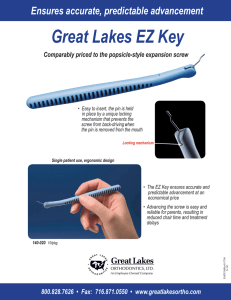
Fastfix Direct : Tools Fasteners and Fixings
Page 1 of 4
Items
FASTENERS AND
FIXINGS
Machine Screw Information
Allthread Threaded
Rod
Anchor Bolt &
Fixings
Bolting Products
Nuts & Washers
Coach Bolt, Coach
Screw
Cable Ties
Drills, Chucks,
Braces & Awls
Engineering,
Clamping & Pins
Hose Clips, Banding
& Tool Clips
Nails, Pins & Staples
Rivets & Riveters
Security Fasteners &
Bits
Screws, All Types
£0.00
Machine screws
Materials available include Steel, Stainless steel and Brass.
Countersunk machine screw (Measure: total length).
A Countersunk machine screws is designed to fit flush with the surface of the fastened
material for a smooth safe finish.
Raised Countersunk machine screw.
A raised head on a countersunk machine screw giving a slightly rounded top for a
more finished look.
Pan head machine screw (Measure: from under head).
A domed head machine screw sits on the surface of the material to be fastened, has a
flat underside and can be used with washers.
Cheese Head machine Screw (Measure: from under head).
Head style: Slotted. A Cheese head machine screw sits on the surface of the material
to be fastened and have a flat underside, can be used with washers.
Round Head machine screw (Measure: from under head).
Head style: Slotted. A Round head machine screw sits on the surface of the material
to be fastened and have a flat underside, can be used with washers.
Shapes of screw head
(a) Pan, (b) Button, (c) Round, (d) Truss, (e) Flat, (f) Oval
Pan head: a low disc with chamfered outer edge.
Button or dome head: cylindrical with a rounded top.
Round: dome-shaped, commonly used for machine screws.
Truss: lower-profile dome designed to prevent tampering.
Flat or Countersunk: conical, with flat outer face and tapering inner face allowing
it to sink into the material, very common for wood screws.
Oval: countersunk with a rounded top.
Cheese head: disc with cylindrical outer edge, height approximately half the
head diameter.
Fillister head: cylindrical, but with a slightly convex top surface.
Socket head: cylindrical, relatively high, with different types of sockets (hex,
square Torx, etc.)
Mirror screw head: countersunk head with a tapped hole to receive a separate
screw-in chrome-plated cover, used for attaching mirrors.
Headless machine screws, called "setscrews" or "grubscrews", are also used. They
either have a socket or a slot.
Types of machine screw drive
Modern machine screws employ a wide variety of drive designs, each requiring a
different kind of tool to drive in or extract them. The most common screw drives are
the slotted and Phillips; hex, Robertson, and torx are also common in some
Fastfix Direct : Tools Fasteners and Fixings
Page 2 of 4
applications. Some types of drive are intended for automatic assembly in massproduction of such items as automobiles. More exotic screw drive types may be used
in situations where tampering is undesirable, such as in electronic appliances that
should not be serviced by the home repairperson.
(a) Slotted, (b) Phillips, (c) Pozidriv, (d) Torx, (e) Hex, (f) Robertson, (g) Tri-Wing, (h) Torq-Set, (i) Spanner
Slot head has a single slot, and is driven by a flat-bladed screwdriver. The
slotted screw is common in woodworking applications, but is not often seen in
applications where a power driver would be used, due to the tendency of a
power driver to slip out of the head and potentially damage the surrounding
material.
Cross-head, cross-point or Phillips screw has a "+"-shaped slot and is driven by
a cross-head screwdriver, designed originally for use with mechanical screwing
machines. The Phillips screw drive has slightly rounded corners in the tool
recess, and was designed so the driver will slip out, or cam out, under strain to
prevent over-tightening. The Phillips Screw Company was founded in Oregon in
1933 by Henry F. Phillips, who bought the design from J. P. Thompson. Phillips
was unable to manufacture the design, so he passed the patent to the American
Screw Company, who were the first to manufacture it.
Pozidriv is patented, similar to cross-head but designed not to slip, or come out.
It has four additional points of contact, and does not have the rounded corners
that the Phillips screw drive has. Phillips screwdrivers will usually work in
Pozidriv screws, but Pozidriv screwdrivers are likely to slip or tear out the screw
head when used in Phillips screws. Pozidriv was jointly patented by the Phillips
Screw Company and American Screw Company.
Torx is a star-shaped or splined bit with six rounded points. These were found
in early Apple Macintosh computers, to discourage home repairs. A "tamperproof" type of Torx head has a small pin inside the socket.
Hexagonal or hex screw head has a hexagonal hole and is driven by a hexagonal
wrench, sometimes called an Allen key, or by a power tool with a hexagonal bit.
Robertson head has a square hole and is driven by a special power-tool bit or
screwdriver. The screw is designed to maximize torque transferred from the
driver, and will not slip, or cam out. It is possible to hold a Robertson screw on a
driver bit horizontally or even pendant, due to a slight wedge fit. Commonly
found in Canada in carpentry and woodworking applications and in Canadianmanufactured electrical wiring items such as receptacles and switch boxes.
square-drive head is an American clone of the Robertson that has a square hole
without taper. Due to the lack of taper, the hole must oversize relative to the
screwdriver, and is much more likely to strip than the Robertson.
Tri-Wing screws have a triangular slotted configuration. They are for instance
used by Nintendo on its Game Boys to discourage home repair.
Torx-Set is an uncommon screw drive that may be confused with Phillips;
however, the four legs of the contact area are offset in this drive type.
Spanner drive uses two round holes opposite each other, and is designed to
prevent tampering. Commonly seen in elevators in the United States.
Tamper resistant machine screw
tamper-resistant Torx driver
Many screw drives, including Phillips, Torx, and Hexagonal, are also manufactured in
tamper-resistant form. These typically have a pin protruding in the centre of the bit,
necessitating a special tool for extraction.
one-way slotted screw
The slotted screw drive also comes in a tamper-resistant one-way design with sloped
edges; the screw can be driven in, but the bit slips out in the reverse direction.
Fastfix Direct : Tools Fasteners and Fixings
Page 3 of 4
Tools used
The hand tool used to drive in most screws is called a screwdriver. A power tool that
does the same job is a power screwdriver; power drills may also be used with screwdriving attachments. Where the holding power of the screwed joint is critical, torquemeasuring and torque-limiting screwdrivers are used to insure sufficient and not
excess force is developed by the screw. The hand tool for driving cap screws and other
types is called a spanner (UK usage) or wrench (US usage).
Machine Screw measurements
There are many systems for specifying the dimensions of machine screws, but in much
of the world the ISO preferred series metric has displaced the many older systems.
See also: Unified Thread Standard.
Metric machine screws
The diameter of a ISO preferred series machine screw is usually specified in
millimetres (mm) prefixed by the capital letter M, as in "M6" for a 6 mm diameter
screw.
The pitch of metric threads varies according to the diameter, but not absolutely
regularly. Some examples: a M3 thread has a 0.5 mm pitch, M4 0.7 mm, M6: 1 mm,
M10: 1.5 mm, M12: 1.75 mm, M14: 2 mm, M16: 2 mm, M18 to M22: 2.5 mm.
The diameter of a metric machine screw is the outer diameter of the thread. The
tapped hole (or nut) into which the screw fits, has an internal diameter which is the
size of the screw minus the pitch of the thread. Thus, an M6 screw, which has a pitch
of 1 mm, is made by threading a 6 mm shaft, and the nut or threaded hole is made by
tapping threads in a 5 mm hole.
Metric machine screw threads are also available in "fine pitch" versions, sometimes
several pitches for one diameter (example: M18/fine in 1, 1.5 and 2 mm pitches). The
fine thread series is deprecated and not recommended for use in new designs. The fine
metric threads were once found in equipment made in the Far East, but that has
changed with the standardisation of the ISO preferred thread series.
Non-metric machine screws
Before the metric system was common, many engineering companies had their own
standard screw sizes. The first person to create a standard (in about 1841) was the
English engineer Sir Joseph Whitworth. Whitworth screw sizes are still used, both for
repairing old machinery and where a coarser thread than the metric fastener thread is
required. This system had two thread sizes: coarse (BSW) and fine (BSF). The thread
angle was 55°.
A later standard in the UK was the BA system, named after the British Association for
Advancement of Science. Screws were described as "2BA", "4BA" etc., the odd
numbers being rarely used. While not related to ISO metric screws, the sizes were
actually defined in metric terms, a 0BA thread having a 1 mm pitch. These are still the
most common threads in some niche applications. Certain types of fine machinery,
such as moving-coil meters, tend to have BA threads wherever they are manufactured.
Curiosly enough, even though every other fastener on a camera may use metric
threads, the tripod socket will likely be a 1/4"-20 thread.
The USA has its own system, usually called the Unified Thread Standard. A version of
this standard, called SAE for the Society of Automotive Engineers, was used in the
American automobile industry. The SAE is still associated with inch based fasteners by
the public even though the U.S. auto industry (and other heavy industries relying on
SAE) switched to ISO preferred series fasteners back in the 1970s and afterwards.
Screws are described as 4-40, 6-32, 8-32, 10-32, 10-24, etc. (for numeric sizes, odd
numbers are rare), or 1/4"-20, 1/4"-28, etc. (for inch unit sizes), with the first number
giving shaft diameter (numeric or inches) and the second number being threads per
inch.
These machine screws are sometimes found outside the USA in older model personal
computers based on the IBM PC specification. Since the computer industry is now
based in Asia (mostly Taiwan), the industry now uses metric fasteners. As more and
more products are made outside the U.S. and then imported into the U.S., the use of
inch based fasteners is declining, and it is only a matter of time before the inch
fastener series is gone forever.
Fastfix Direct : Tools Fasteners and Fixings
Page 4 of 4
Other thread systems include BSP (British Steam Pipe; used for other purposes as
well) and CEI (Cycle Engineers Institute, used on bicycles in Britain and possibly
elsewhere), NPT and NPTF (coarse and fine pipe threads), and PG (German: "PanzerGewinde"), used in thin plate metal, such as for switches and nipples in electrical
equipment housings.
History
In antiquity, the Greek mathematician Archytas of Tarentum (428 – 350 BC) was
credited with the invention of the screw. By the 1st century BC, wooden screws were
commonly used throughout the Mediterranean world in devices such as oil and wine
presses. Metal screws did not appear in Europe until the 1400s.
The metal screw did not become a common woodworking fastener until machine tools
for mass production it were developed at the end of the 18th century. The British
engineer Henry Maudslay patented a screw-cutting lathe in 1797; a similar device was
patented by David Wilkinson in the United States the next year.
Standardization of screw thread forms accelerated during WWII so that
interchangeable parts could be produced by any of the Allied countries.
?Copyright 2003-2007 fastfix. All rights reserved.
Web design by Ellipsis Media Ltd.




